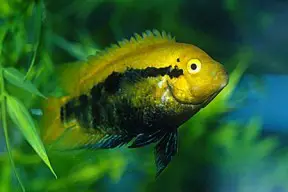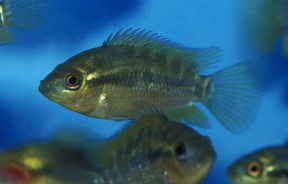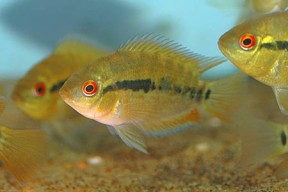Herotilapia multispinosa
Rainbow Cichlid
Classification
Cichlidae. Subfamily: Cichlasomatinae
Distribution
Occurs in eastern Honduras and throughout Nicaragua and Costa Rica. It’s Atlantic (eastern) range extends south from the River Patuca in Honduras to the River Matina in Costa Rica. In the west it can be found from the River Guasaule in Nicaragua to the Costa Rican Rivers of Tempisque and Bebedero.
Habitat
Most often inhabits turbid waters with soft, muddy substrates including inland lakes, swamps and marshes.
Maximum Standard Length
7″ (17.5cm) although this would be exceptional in the aquarium, typically around 4″ (10cm)
Aquarium SizeTop ↑
36″ x 15″ x 12″ (90cm x 37.5cm x 30cm) – 100 litres
Maintenance
Sand subtrate should be used, although this fish would actually prefer a muddy bottom which would pose a challenge to the aquarist. Other tank decor is not critical, although the Rainbow cichlid will appreciate areas of planting in which it can take cover. Water flow should be slow to moderate and lighting not overly strong.
Water Conditions
Temperature: Occurs in waters as warm as 91°F (33°C) in the wild! However 72 – 82°F (22 – 28°C) is suggested in the aquarium.
pH: 7.0 – 8.0
Hardness: Up to 20°H
Diet
Feeds mainly on detritus in nature, including a great deal of algae and other plant matter. Not a fussy eater in captivity. Feed a high quality cichlid pellet as staple and vary often with frozen and livefoods. Will especially appreciate brineshrimp. Vegetable/spirulina flakes or similar will also be accepted.
Behaviour and CompatibilityTop ↑
A peaceful cichlid, especially by Central American standards, which will appreciate tankmates of a similar disposition. Tetras barbs and other smaller peaceful cichlids can all be considered. Small plecs and doradids make suitable bottom-dwellers.
Sexual Dimorphism
Can be difficult to distinguish. Male is likely to have more pointed dorsal and anal fins.
Reproduction
Best spawned is a separate breeding tank.
A spawning site will be cleaned, usually a bit of smooth-surfaced rock. Slate is ideal for this purpose. The female will lay the eggs, then the male will move in to fertilise them. Both parents will then fan the eggs with their pelvic fins to provide oxygenated water to the eggs. Eggs can take upto 2 days to hatch (at this point they may be moved into other designated spawning pits), and up to a week later the fry will be free swimming.
NotesTop ↑
Relatively common in the hobby, the Rainbow Cichlid makes an ideal CA cichlid for those who do not wish to manage the challenge of the more aggressive CA species.




